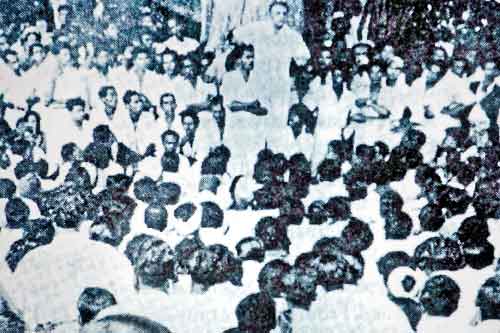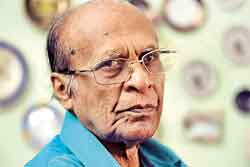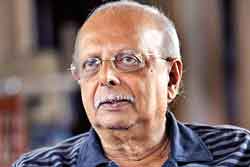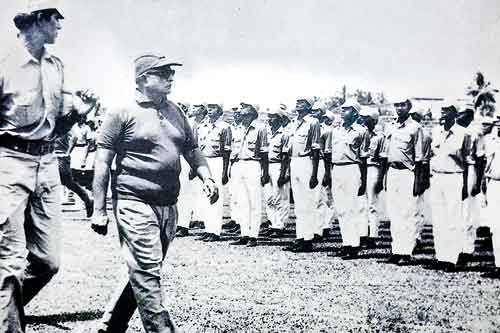The young comrades who took on Colombo’s ‘Comprador Capitalists’
Peace, land, bread!

N.M. Perera addressing a workers’ rally at Price Park
This was the rallying cry which changed the course of world history, the very core of not just a revolution, but the ‘Great’ October Revolution.
Even though the vibrations of the Great October Revolution in Russia — the 100th anniversary of which is being celebrated with much pageantry and fanfare in Sri Lanka next week – shook the world, including neighbour India, it permeated then Ceylon only years later.
Ceylon was very much a colony of the British Empire in 1917, when the Great October Revolution put paid to imperialism and capitalism ensuring these interests were trampled into the dust and the rights of the voiceless, the soldier (peace), the serf or worker (land) and the common man (bread but in our case it seems to have been parippu) were propelled to the forefront.
From within Ceylon too there was a group of young men and women who ‘saw’ red and embraced red, ‘brandishing’ the symbols of the sickle (the tool of the peasant) and the hammer (the tool of the worker). These were intellectuals who had crossed the oceans to seek higher learning in Britain who came under the powerful influence of socialism, the mantra for equality among all.
They are no more and we seek the ‘third generation’ followers of socialism to get a glimpse of those early times, who have had close bonds with both the ‘first’ and the ‘second’ generations.
As we walk into the homes of Lanka Sama Samaja Party (LSSP) Leader Dr. Tissa Vitarana at Nawala and Communist Party of Sri Lanka (CPSL) Leader Don Edwin Weerasinghe Gunasekara at Kotte, there is a sense that they are following the ideals of socialism to the letter. Charming and simple are their homes unlike those of many modern-day politicians who are living amidst much opulence.

Communist Party leader D.E.W. Gunasekera
A Ceylon very different to what Sri Lanka is today is opened up to us by 83-year-old Dr. Vitarana………a land in the stranglehold of a colonial power, its wealth being channelled back to Britain with impunity and the emergence of ‘Comprador Capitalists’ comprising the Colombo elite including both Sinhalese and Tamils who were tied to the imperialist rulers as they were trading in British goods or involved in the plantation sector, while the majority, the ‘common people’, were living in abject poverty and facing vicissitudes.
Downtrodden were the rural and also the women folk with caste discrimination rampant and women having to walk around with bare-bosoms. Those were the days whenever the Rate Mahattaya passed by, the commoners had to dive into the drains away from his path.
“With facilities for education in Ceylon being limited, the brightest students had the option of going abroad and among them were Dr. N.M. Perera, Dr. Colvin R. de Silva, Dr. S.A. Wickremasinghe and Philip Gunawardena,” says Dr. Vitarana.
Not only did these silver-tongued intellectuals have great minds, excelling in their fields be it economics or medicine, they were also true nationalists, with a passion to eradicate poverty and inequality. They had socialist ideals gravitating towards Marxism, says Dr. Vitarana who got initiated into this line of thinking as he shadowed Dr. Perera, his maternal uncle. While Dr. Perera would share all his ‘Economist’ magazines with left-leaning articles with his nephew, numerous were the chats of the duo.
“The imperialist era marked intense exploitation of Asian countries and these intellectuals found that Marxism was the answer to the problem. Some of them like Dr. Perera had visited the Soviet Union,” he says.

LSSP Leader Dr. Tissa Vitarana
When these idealists returned to Ceylon, the plight of the common man had not changed. Out on the streets, bright red poppies with black hearts were being sold, with the proceeds being siphoned back to war veterans in Britain, without a penny for the Ceylonese soldiers who had been part of the British Army in World War I.
To counter the poppy campaign came the Suriya-Mal Movement spearheaded by ex-serviceman Aelian Perera and several activists including Doreen, the wife of Dr. Wickremasinghe, who boldly wrote on ‘The Battle of the Flowers’ to the newspapers of that time. The poppy- suriya-mal sellers’ war on November 11 every year went on till World War II.
The Suriya-Mal Movement, was an unexpected success and the surplus funds they decided to distribute among the shivering and starving people wracked by malaria in the Thun Korale.
Into the remotest corners affected by the malaria epidemic as well as malnutrition, which the British rulers were ignoring in 1932-33, the young socialists went, bearing not only money but also lugging heavy loads of food including pulses such as dhal and medicine such as quinine.
What they saw was a grim picture – nearly a million had been struck down by malaria, leaving 125,000 dead. People were dying of starvation and when whole families were hit by malaria, there was no one to bury the dead, says Dr. Vitarana, adding that N.M., Philip and the others took it upon themselves to help bury the dead, while feeding and tending the sick.
Smilingly, he says that even now in areas such as Yatiyantota and Deraniyagala, people refer to N.M as ‘Parippu Mahattaya’ (Mr. Dhal). What, of course, the humble village folk did not know was that he was brilliant, with the respected Prof. Harold Laski, the Professor of Economics and Political Science of the prestigious London School of Economics (LSE) saying that “my best student was Asian — he would have made a great Finance Minister for Britain”, referring to N.M.
With images of the suffering masses seared into their minds, December 18, 1935 saw the birth of the LSSP or the Lanka Equal Society Party, the first functional party to be registered in the history of the country. “Socialist ideas were at the forefront of the formation of the LSSP. Socialism essentially theorized that production should be to meet human need and not to make profits for a small group of people,” points out Dr. Vitarana, describing how the LSSP members fanned out to the villages taking the message of socialism.
Even before the formation proper of the LSSP, these frontline socialists were putting out a strident call for universal adult franchise (the vote for the people) which was granted by the British to both men and women in Ceylon, a major victory in 1931. It was the first colony to enjoy this privilege.
According to Dr. Vitarana the LSSP was formed with 22 objectives, the core of which was to build a socialist society, an ‘equal society’ or ‘Sama Samajaya’ to get rid of class differences by uplifting rural and slum-dwelling people to be on par with the rest of society.
The other objectives included free health, free education, pensions, an eight-hour working day with overtime if people worked longer, trade union rights, land rights et al.
A major event was when Mark Anthony Bracegirdle, a young Australian creeper on an estate, decided to throw in his lot with the LSSP in November 1936 and was introduced by Dr. Colvin R. de Silva as a “white comrade” who had even attended a meeting held at a street corner.
By this time the socialists had got a toe-hold in the State Council, with Dr. S.A. Wickremasinghe being elected from Morawaka in 1931 and Dr. N.M. Perera and Philip Gunawardena winning seats on the State Council of 1936 from Ruwanwella and Avissawella respectively.
When World War II erupted, with the British calling it a war against Fascism and mobilizing support in their colonies, the LSSP stood in direct opposition dubbing it an imperialist war, where colonial powers were trying to divide the world among themselves. It was then that the LSSP’s non-violent radicals brought the wrath of the colonial masters on themselves.
Incarceration, jail-breaks, declaration of the LSSP as illegal, some members going underground, some surreptitiously crossing over to India, arrests and imprisonment over there and some of them being brought back to be jailed here, dotted the chequered history of the LSSP.
Dr. Vitarana recalls visiting his uncle at a prison near the Kandy Railway Station. As the LSSP prisoners filed in unrecognizable due to their long, unkempt beards, nowhere to be seen had been N.M. Always duty-conscious, he was completing his day’s assigned quota of husking coconuts.
Referring to the rights that the LSSP has won for the people, Dr. Vitarana says that as outstanding intellectuals and articulate politicians, they were on several committees for health, education and other crucial matters set up under the Donoughmore Constitution. The Chairman of the Education Committee was C.W.W Kannangara, but the LSSP members, with their brilliant arguments and skill of repartee were able to win many rights including a level playing field in education for all children.
Another of the LSSP’s major struggles was to secure “complete” independence, while the Comprador Capitalists were only interested in gaining partial independence, transference of certain powers to their class, he explains, contrasting the situation in India. “We got dominion status in 1948, but India led by Mahatma Gandhi, Jawaharlal Nehru and Rabindranath Tagore achieved independence in 1947 and by 1950 even introduced a Republican Constitution. However, Ceylon got rid of its colonial shackles only in 1972, that too when the LSSP stalwarts in the then government drafted its Republican Constitution.
After Ceylon gained independence, it was an upward journey for the LSSP until 1977 when liberalization of the economy impacted on the working class and the trade unions.
Explaining that in 1956, the LSSP was the main opposition party in Parliament which was virulently opposed to the Sinhala-only Policy, Dr. Vitarana highlights the LSSP’s golden period as being the years from 1970 to 1975 when it had many members in Parliament and Dr. N.M. Perera was the Finance Minister, who would make the country’s accounts himself, while Dr. Colvin R. de Silva was the Plantations Minister.
The conversation becomes more personal as Dr. Vitarana shows us a different side of the astute politician Dr. N.M. Perera. “He was the first Ceylonese star to act in a film.”
He played the lead role in the silent film ‘Rajakeeya Wickramaya’ filmed in Bombay in 1925. It was only screened in Singapore but never in Ceylon as the one-and-only print got destroyed in a “mysterious’ accident at the studio in Bombay.

Youth to the fore: N.M. inspects an LSSP youth league battalion
Dr. Perera was also not just a brilliant economist but an all-rounder captaining the cricket team of Ananda College and Dr. Vitarana jogs our memory that he also played for the N.C.C and was President of the Board of Control for Cricket in Sri Lanka.
It is 80-year-old D.E.W. Gunasekara of the CP, meanwhile, who groups the socialists into the three generations – the ‘first’ being Dr. S.A. Wickremasinghe, Dr. N.M. Perera, Dr. Colvin R. de Silva, Philip Gunawardena and Leslie Gunawardene; the ‘second’ Pieter Keuneman and his peers who came on the scene in the 1940s; and the ‘third’, the current socialists.
While preparing to hold a massive cultural pageant on Tuesday (November 7) in celebration of the Great October Revolution, he waxes eloquent on the “biggest” event of the 20th century.
Sporting a bright-blue shirt when we meet him, when asked, he jokes that red shirts are for the street, for when they go a-marching.
“The revolution’s biggest impact was on Asia. Prior to that only Europe had a leftist movement. After 1917, it spread to Asia and soon after, in 1921, the first National Congress of the Chinese Communist Party was held in Shanghai,” he says.
Let me tell you a secret, murmurs Mr. Gunasekara, pointing out that in an era sans quick and advanced communications such as mobile phones and e-mails or even efficient faxes, it was Ponnambalam Arunachalam who was the first to declare to Ceylon, at a meeting in Jaffna in December 1917, that a socialist revolution had spread through Russia like wildfire.
History flows forth easily from him…..The first act of Lenin being the declaration of world peace, with Russia withdrawing from World War I. He liberated Finland, the first country to gain independence from colonial rule and that is why Finland is celebrating its 100 years of independence this year. “Intellectuals were the forerunners of socialism and India’s Jawaharlal Nehru and Mahatma Gandhi and China’s Sun Yat-Sun, Founder of the Republic, were the first to congratulate Lenin. But Ceylon under the British kept mum, while the ‘Times of Ceylon’ branded Arunachalam a fascist.
However, the British could not stop the inevitable spread of socialism — A.E. Goonesinghe forming the Ceylon Labour Union and lawyer Valentine S. Perera launching the Youth League at the Wellawatte Plaza Theatre with India’s Jawaharlal Nehru as chief guest, which later metamorphosed to the All Ceylon Youth League, he says.
“The pre-independence era was the most militant for the leftist movement, when the leftists of Ceylon were young and idealistic,” says Mr. Gunasekara, dividing the eras of socialism into three – pre-independence; post-independence; and after 1977. The period after 1977 during the Presidency of J.R. Jayewardene when neo-liberal economic policies were introduced was the start of the waning of the leftist movement.
He echoes the views of Dr. Vitarana on the left movement’s fight for total independence, the seeds sown by the October Revolution, whereas others were only wanting constitutional reforms. The second period was marked by strong policy-making and strengthening of the peasant and trade union movements. It was not a united left but the parties worked together to bring about rent laws, housing-ceiling laws, low-cost housing, nationalization of estates, nationalization of bus services etc.
He cites the power of the leftists when he speaks of the hartal of 1953 when the price of rice rose from 25 cents to 70 cents due to the subsidy in the form of the ‘haal potha’ being abolished and the whole country came onto the streets.
In 1977, the entire left was wiped out from Parliament, with J.R. winning a five-sixth majority. Liberalization and privatization became the order of the day. But, laments Mr. Gunasekara, it was also the beginning of the debt-trap, with the revision of the taxation policy.
The rest, of course, is history…….with the socialists also breaking into factions over the years – starting with the LSSP in 1935; the CP in 1943; the Viplavakari LSSP in 1945; the Janatha Vimukthi Peramuna (JVP) in 1965; the Democratic Left Front in 1999;the Frontline Socialist Party (Peratugamee Samajavadhi Pakshaya) in 2012; and the United Left Front in 2017.
| How it came to be called the October Revolution | |
| Two revolutions shook Russia in 1917. In the smaller ‘February Revolution’, unrest in the country followed the formation of a provisional government by the Duma (representative assemblies) and Czar Nicholas II’s abdication. However, Russia’s involvement in World War I left a trail of starvation and the country descended into food riots. Incidentally, at that time as Russia was following the Julian calendar (proposed by Julius Caesar in 46 BC — a reform of the Roman calendar), though the revolution occurred in March 1917, it was called the ‘February Revolution.’ The second bigger revolution, occurred on November 6 and 7, but according to the Julian calendar on October 24 and 25 and was thus dubbed the ‘October Revolution’. |


